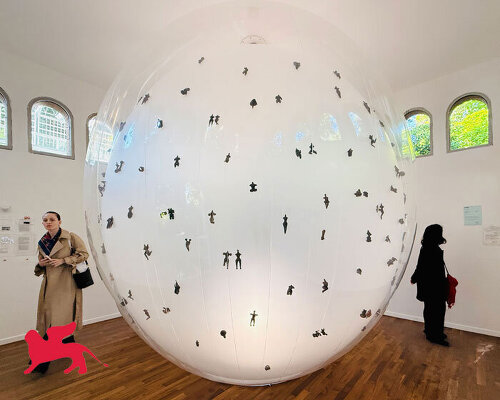Unbuilding to Unearth: 30 Million Years Beneath Korean Pavilion
At the 2025 Venice Biennale, the Korean Pavilion engages in a process of self-unbuilding, reconfiguring the national pavilion as a porous, adaptive structure shaped by trees, time, and the unhuman. The exhibition reconsiders spatial boundaries and historical constructs, integrating built and unbuilt elements above and below ground level.
Marking its 30th year at the International Architecture Exhibition – La Biennale di Venezia, the pavilion does not expand its architectural presence but revisits it through subtraction and reinterpretation. The exhibition, titled Little Toad, Little Toad: Unbuilding Pavilion, derives its name from a Korean children’s song associated with cycles of destruction and renewal. Curated by the Curating Architecture Collective (CAC), the exhibition unfolds across a series of site-responsive installations by ATELIER KHJ’s Kim Hyunjong, Studio Heech’s Heechan Park, Flora and Fauna’s Lee Dammy, and Plastique Fantastique’s Yena Young, each navigating the thresholds of construction and disappearance, permanence and ephemerality. Together, their works unbuild the pavilion not through destruction, but through acts of listening, layering, and looking beneath the surface.
the Korean Pavilion unbuilds itself at the 2025 Venice Biennale | image by © Yongjoon Choi
Yena Young’s installation draws from archaeological fiction
It is beneath this surface that Yena Young’s (Plastique Fantastique, see more here) installation quietly shifts the ground. Titled 30 Million Years Under the Pavilion, her work imagines the Korean Pavilion as an accidental capstone atop a fossilized mystery. Drawing from speculative science and archaeological fiction, Young excavates the story of Nanogyna acephala, a headless, hominid-like organism allegedly unearthed in 1993 beneath the very soil of the Giardini. Through surveillance feeds, animals living underneath, and half-buried figurines, her work opens a portal not just to a fictional past, but to a destabilized present. What narratives have been lost, buried, or excluded in the construction of cultural identity? Just as the toad in the curatorial title is a mythic figure of transformation and trickery, Nanogyna embodies a radical form of re-memory: a creature that challenges scientific certainty, evolutionary hierarchy, and even bodily design. It is not a monument, but a murmur, reminding us that unbuilding is not only architectural, but biological, historical, and environmental.
a porous structure shaped by trees, time, and the unhuman | image by © designboom
Exhibition explores Architecture in Continuous Regeneration
Above ground, the pavilion continues to be gently unsettled: Heechan Park’s (Studio Heech, see more here) intervention traces the interdependence between the built structure and the trees surrounding it; Lee Dammy’s (Flora and Fauna, see more here) ghostly layers recompose forgotten narratives in the walls; Kim Hyunjong’s (ATELIER KHJ, see more here) rooftop observatory orients the pavilion toward new horizons. Together, these gestures challenge the traditional role of the national pavilion and ask: what is preserved, and what is erased, in the name of architecture? In this 30th year, the Korean Pavilion does not mark a legacy in stone, but in sediment. Little Toad, Little Toad is not about arrival, but about continuous regeneration, architectural, ecological, and imaginary. And down below, in the shadowy underlayer, Nanogyna waits, a reminder that even the most stable foundations rest on myth, soil, and time.
‘Little Toad, Little Toad’ draws from cycles of destruction and renewal | image by © Yena Young
the pavilion marks 30 years by dismantling its own boundaries | image by © Yena Young
Incubator for Nanogyna acephala | image by © Yena Young
architecture reimagined through presence and absence | image by © Yena Young
Yena Young imagines what lies beneath the pavilion | image by © designboom
fossilized fiction beneath the Giardini | image by © designboom
tracing what architecture chooses to preserve, or erase | image by © Yena Young
under the pavilion Nanogyna acephala | image by © Yena Young
surveillance feeds and half-buried figures suggest deeper layers | image by © Yena Young
inventory of Nanogyna acephala | image by © Yena Young
Nanogyna is not a monument, but a murmur in the soil | image by © Yena Young
project info:
name: 30 Million Years Under the Pavilion
exhibition: Little Toad, Little Toad: Unbuilding Pavilion
designer: Plastique Fantastique | @plastique.fantastique
lead designer: Yena Young
artists/architects: Kim Hyunjong – ATELIER KHJ | @atelier_khj, Heechan Park – Studio Heech | @studioheech, Lee Dammy – Flora and Fauna | @florafaunavisions, Yena Young – Plastique Fantastique | @plastique.fantastique
venue: Korean Pavilion, Giardini, Venice
dates: May 10th – November 23th, 2025
curated by: Curating Architecture Collective (CAC)
designboom has received this project from our DIY submissions feature, where we welcome our readers to submit their own work for publication. see more project submissions from our readers here.
edited by: christina vergopoulou | designboom
The post plastique fantastique reveals fossilized mysteries beneath korean pavilion at venice biennale appeared first on designboom | architecture & design magazine.

